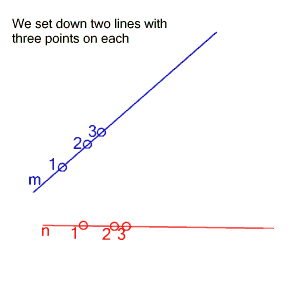Continuity
We consider a pair of projectively-identical, skew rulers, one red, and one blue, made equivalent by projectivity via an intermediate, green ruler.Consider just one, black, skew line of the set of skews that directly link end-points of intervals on the red ruler to end-points of intervals on the blue ruler, and how – strictly projectively – to move that skew. When we know how to do that for one, we can generalise to the others.
figure 1
A red line in red point M joins a red point, say R, in the red ruler, to a point, say Q, in the green ruler. A blue line in blue point N joins that point Q to a blue point, say B, in the blue ruler. The join of the red point R in the red ruler to the blue point B in the blue ruler is our single, black, skew line.
All these joins, and the points they join, are coplanar, in, say, plane γ. If we wish to move the skew line, we might “move” the green point Q in its green line by swinging plane γ around the line joining M to N, or, instead, “move” Q to swing γ. (Since lines have only extension, and hence do not have location or position [points have that], we here refer to "stations", rather than positions, of a line.)
The question now is whether or not we can projectively move point Q, or rotate plane γ, smoothly and continuously.
If we simply assume that smooth, continuous motion of an element is available (as we well might when seeing that an element, such as Q, above, apparently may be “dragged” continuously on-screen), we should remind ourselves that this is a peculiar Euclideo-Newtonian assumption, of a kind rejected from the start by non-Euclidean, Projective Geometry. The on-screen dragging is in any case not smooth, but occurs in discrete, digital steps. The smoothness and continuity are illusory.
Now, we have a perspectivity in
Q,
meaning that every skew interval, RB, bridging the rulers, is equivalent to the
interpunctual interval MN, and that, therefore, each is equivalent to every other.
Also, two or more such intervals formed by the same skew, moved, are equivalent. Bear in mind that each skew is just that - skew - so can never touch any other - this means that two, successive "stations" of the same, moved skew cannot be incident with each other in any way at all.
It must follow that the passage from one skew "station" to the next cannot be continuous, but must be discrete.
Also, two or more such intervals formed by the same skew, moved, are equivalent. Bear in mind that each skew is just that - skew - so can never touch any other - this means that two, successive "stations" of the same, moved skew cannot be incident with each other in any way at all.
It must follow that the passage from one skew "station" to the next cannot be continuous, but must be discrete.
The “Fundamental” Theorem
The theorem shows that a maximum of two, arbitrary, contiguous, interpunctual intervals per line, on distinct lines, can be made equivalent by projectivity. It does not say that intervals on the same line are equivalent to each other.You may control this animation by left-clicking the buttons below it.

animation



figure 2
Notice that the two lines, red and blue, here called m and n, can
be, but need not be, coplanar. So in every
respect of geometric principle, except for the fact that these lines do not necessarily bear identical rulers, and that their colours
happen to have been swapped, figure 2 matches figure 1 in the leftmost column.
figure 2
- The red point 1 of fig. 2 is point H of fig. 1:
- the intermediate line of fig. 2 is the green line of fig. 1:
- point G is the incidence of this intermediate line with the blue line, m.
If m and n are coplanar, all the bridging lines (the black lines here) are too, and so each must meet every other in a point, one per pair of lines. They might then envelope a curve, as tangents, but these meeting-points can not lie in that curve. If their several meeting-points happen to merge/degenerate into a single point, there will be no curve of any kind.
It is Important to realise that
there is
no way
to tell from either figure 1 or figure 2 whether m and n are in
objective fact
coplanar or skew. However, it is always possible to find the
“shadows” of skews on a plane – and these shadows must,
perforce, be
coplanar!